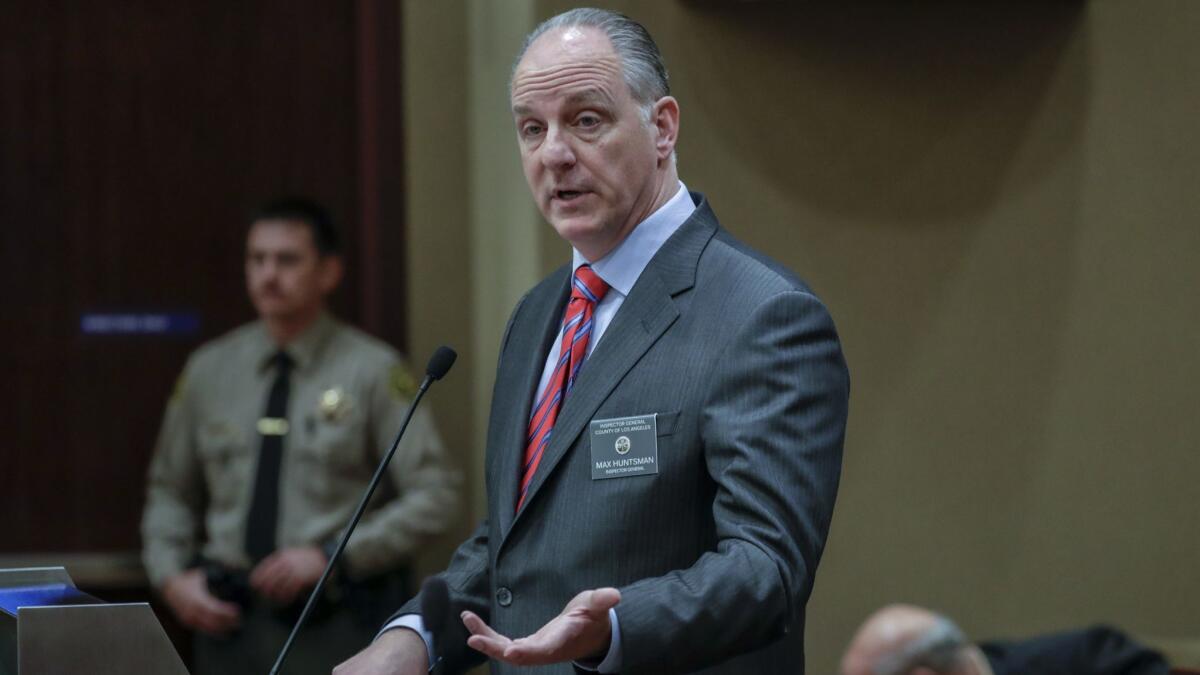L.A. County sheriff’s team violated civil rights of drivers on 5 Freeway, inspector general says

- Share via
Los Angeles County’s inspector general said Thursday that a Sheriff’s Department team that pulled over thousands of innocent Latino motorists on the 5 Freeway in search of drugs violated the constitutional rights of drivers, and he questioned the reason for the unit’s existence.
In a damning verbal report to the department’s civilian oversight panel, Max Huntsman criticized Sheriff’s Department officials for inadequate supervision of the highway drug unit and for failing to take heed of several federal court rulings that found the deputies on the team violated the rights of motorists by detaining them longer than was reasonable.
Adding that “the initial premise of this drug enforcement team was flawed,” Huntsman said the department had no evidence the unit had had a measurable impact on the flow of drugs from Mexico.
“The system is inherently built to violate the constitutional rights of a vast number of people passing through the I-5 Freeway,” Huntsman said. “That’s a problem.”
Huntsman began his investigation of the team after a Times analysis last month found that 69% of drivers stopped by the deputies were Latino and that two-thirds of them had their vehicles searched — a rate far higher than motorists of other racial and ethnic groups. Cars belonging to all other drivers were searched less than half the time, according to the newspaper’s analysis of Sheriff’s Department stop data.
Deputies found drugs or other illegal items in the vehicles of Latino motorists at a rate that was not significantly higher than that of black or white drivers, The Times found.
Some Latino drivers pulled over by the team have said they believe they were the victims of racial profiling.
Huntsman said his staff recently conducted ride-alongs with the team’s deputies and saw no signs they were using race or other biased factors when deciding whom to stop or search. Huntsman is still gathering data on the team’s traffic stops that he plans to analyze for evidence of racial disparities.
But Huntsman, who is in the early stages of his investigation, said some facts had already become clear. Regardless of whether his upcoming review of traffic stops finds evidence of racial profiling, Huntsman noted that only a small fraction of the more than 9,000 people who were stopped by the team faced criminal charges, adding that some portion of those drivers were “subjected to unlawful detentions.”
“That’s the obvious and inevitable result of a process where you have deputies who simply stop people on a pretext and then try to develop probable cause” to search for drugs, he told members of the Sheriff Civilian Oversight Commission.
A Sheriff’s Department official at the meeting did not respond to Huntsman’s criticisms, and a spokeswoman for the department did not immediately respond to a request for comment.
Huntsman said the problems echo those in recent years in the Antelope Valley, where the U.S. Department of Justice found that sheriff’s deputies were making racially biased traffic stops and improperly detaining drivers in police vehicles. The department reached a legal settlement with federal officials in 2013 that called for significant reforms and outside oversight.
The inspector general cited the federal findings, which blamed “tolerance for misconduct” on a lack of supervision and accountability within the department.
“That’s exactly what was happening in this case here,” Huntsman said.
The parallels to Antelope Valley, Huntsman said, highlighted the need for auditors in the Sheriff’s Department to analyze data on the highway team’s traffic stops. He also called on department officials to examine the team’s policies and procedures and explain why video cameras in the team’s vehicles have been shut off.
The problems with the highway team should spur the department to undertake a review of traffic stops made by deputies across the entire agency for signs of racial profiling, he said.
Commissioner Lael Rubin asked the inspector general to examine how deputies on the team were trained and why the dashboard cameras were removed.
“That is a very damning beginning of what I expect your report will ultimately be,” Rubin said. “It raises many issues for us to begin to consider.”
The highway team was launched in 2012 as a response to a spate of drug overdoses in the Santa Clarita area, department officials said. Similar units operate around the country as part of a federal program designed to use local and federal law enforcement agencies to combat drug trafficking.
Though the deputies are looking for any criminal, nearly all of the arrests are for drug-related crimes. The 5 Freeway, they say, is a pipeline for cartels to move drugs up the West Coast and return to Mexico with cash from drug sales as well as weapons purchased in the United States.
The team has made more than 1,000 arrests and seized 600 pounds of cocaine and more than a ton of methamphetamine since it was formed. But Huntsman said that without knowing the total supply that is moving through the 5 Freeway corridor, it’s difficult to say whether those efforts have made a measurable dent in the amount of drugs flowing in from Mexico.
“Without an evidence-based analysis, you can have no confidence that this approach is going to be effective in reducing the actual amount of drugs available for people to use,” he said. To combat overdoses, the department would be better off supplying its deputies with naloxone, a drug that reverses the effects of heroin and other opioids, Huntsman said.
After The Times shared the findings of its analysis with the agency earlier this year, Sheriff’s Department officials declined to address the racial disparities but denied that deputies use race as a factor when making stops. Instead, they said, deputies pull over people for traffic violations or other infractions and then look for suspicious behavior or other signs from drivers and passengers that contraband may be hidden in the vehicle.
The Times analyzed traffic stops the California Highway Patrol made in its Newhall patrol area, which includes the section of the 5 where the Sheriff’s Department team makes stops as well as other freeways and roads in the area. It found that in 37% of the traffic stops made by CHP officers, the driver was Latino. Racial profiling experts who reviewed The Times’ findings said the CHP stops from the wider area provide a meaningful comparison and strongly suggest the Sheriff’s Department team is targeting Latinos.
The CHP is compiling statistics on the race of drivers its officers stopped on the same stretch of the 5; Huntsman said he plans to use the data as a comparison to the highway team’s stops.
Some of Huntsman’s harshest criticisms were over the failure of Sheriff’s Department officials to take action after nearly a dozen of the highway team’s arrests came under scrutiny in federal court and were dismissed.
“When something is resulting in a third of your cases getting kicked, that should be a red flag, a siren blaring in your ears,” he said.
UPDATES:
4:20 p.m.: This article was updated with additional details from the commission meeting.
This article was originally published at 2:15 p.m.
More to Read
Sign up for Essential California
The most important California stories and recommendations in your inbox every morning.
You may occasionally receive promotional content from the Los Angeles Times.













